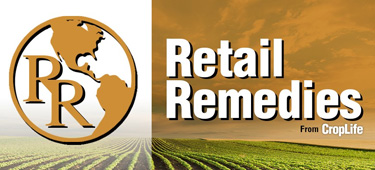Retail Remedies: The Ongoing Promise of Micronutrients in Agriculture
 Editor’s note: This article is part of CropLife’s new series called Retail Remedies. In Retail Remedies content, we offer solutions and strategies for ag retailers to present to their grower-customers to make dealing with all the uncertainty of the 2022 planting season more manageable. This will include stories on product segments — like the micronutrients feature below — that can help growers stretch their hard-earned dollars in this time of higher crop input costs.
Editor’s note: This article is part of CropLife’s new series called Retail Remedies. In Retail Remedies content, we offer solutions and strategies for ag retailers to present to their grower-customers to make dealing with all the uncertainty of the 2022 planting season more manageable. This will include stories on product segments — like the micronutrients feature below — that can help growers stretch their hard-earned dollars in this time of higher crop input costs.

It’s difficult to slow a fast-moving locomotive. Despite the myriad challenges impeding industry growth, micronutrients have chugged along with the speed of a Japanese bullet train.

The micronutrients market segment continues to offer manufacturers and distributors huge potential. Photo courtesy of AgroLiquid
The past few years have been “very successful,” says Galynn Beer, Product Management Lead, AgroLiquid. “Market adoption has been strong as the benefits of micronutrients have been demonstrated. The yield barriers for multiple crops continue to be tested and micros are a big driver in moving the bar higher.”
Despite the recent success, Beer sees some potential issues that while not expected to derail the train, might slow it a bit in 2022.
“‘Shaky,’ is probably the best characterization,” he says. “The radical price increases for primary nutrients will crowd micronutrients out of some growers’ budgets. Availability of some micronutrients is also tight. Also, many micros are ‘game time’ decisions, so demand may not be known until planting is upon us.”
Josh Byford, Coron and Nutritionals Brand Manager with Helena Agri-Enterprises LLC agrees the coming year could be more challenging, and both the company and its clients have worked to mitigate any disruption.
“Due to supply challenges in 2021, customers have been making preparations to ensure availability of key micronutrients for their operations in 2022,” he says. “We continue to see strong demand for enhanced efficiency products that offer maximum agronomic and economic benefits.”
Demand for the products isn’t expected to be the issue.
“Challenging!” is the word Jake Socherman, VP, Strategic Engagement, Verdesian Life Sciences, uses to describe the lead into 2022. “While use and demand for micronutrients across all market segments continues to grow, the issues are more around labor, supply chain and freight which is leading to rising costs and longer lead times.”
One other factor not triggered by COVID-19 and its fallout that could also limit growth is the lack of understanding.
“Nutrient education is affecting the decision-making process,” says Fernando Munoz, General Manager. Scott G. Williams LLC. “It used to be that decisions were made by dividing the price per ton by the units of zinc, etc. in order to make decisions based on dollar per unit of zinc, etc. Slowly but surely, a more sophisticated decision maker is also factoring in the product characteristics such as matrix (oxide vs. chelate), application (pellets for bulk blending vs. coating powders), etc. A more informed decision is usually a better decision.”
Drivers
“As with most things in the agricultural market, commodity prices and weather have been the two largest factors leading to increased demand and usage,” Byford says. “We are also seeing much greater interest from customers in soil and tissue testing services offered through our AGRIntelligence platform. This has allowed Helena agronomists and customers to better understand and identify yield-limiting factors such as micronutrient needs.”
Price is always a factor and when prices rise, growers reassess their input costs.
“Koch Agronomic Services encourages growers to understand the benefits that applying micronutrients could bring to their crops as they also try to capitalize on the commodity grain prices,” explains Tim Laatsch, Director of Agronomy for North America. “While needed in small quantities, micronutrients play a significant role in the crop and how macronutrients, like nitrogen and phosphorus, are used within the crop. Providing balanced and efficient plant nutrition, including micronutrients, is the most effective way to ensure that nutrients will not limit yield potential.”
The prices being offered for commodities has certainly helped this industry segment.
“High commodity prices always have a positive effect on micronutrient usage,” says Tommy Roach, VP of Product Development and Technical Services, Nachurs. “This will go the other direction at some point in time based on history. Ride the wave while it lasts!”
The cost is important, but growers recognize that the better measure is return on the investment.
“As growers and retailers continue to seek higher and more consistent yields, micronutrients are becoming an integral part of the solution,” Socherman says.
Looking Forward
Manufacturers are fully invested in developing the micronutrients market expanding their R&D efforts, delivering new products with proven efficacy, and ensuring they work with existing offerings.
“Based on market research we have gathered, there’s confidence in the industry that the use of micronutrients will continue to grow as growers look to solutions to help overcome yield plateaus and reach those next yield goals,” Laatsch says.
While challenges exist, manufacturers are making sure to hitch their cars to the micronutrient train.
“The current state of the micronutrient industry is challenging but there is plenty of reason to be optimistic,” says Andy Braunshausen, Vice President of Crop Protection Marketing, WinField United. “We continue to see supply chain, transportation, and labor challenges affecting the micronutrient supply through 2022. Despite those challenges we are optimistic that farmer demand will continue to be strong into 2022.”
Nachurs’ Roach is optimistic, too, and offers this advice for growers.
“Given current commodity prices of traditional row crops (corn, soybean, wheat, cotton), I foresee a continued increase in micronutrient utilization,” he says. “With historically high nitrogen, phosphorus, and potash prices growers should not cut back on micronutrients as they have a huge impact on nutrient use efficiency and yield. The only thing that could derail this would be raw material availability as some of the chelating/complexing agents (i.e., EDTA acid, citric acid) used to manufacture micronutrients are in tight or limited supply. For example, some materials that are used to make liquid boron (monoethanolamine) are still not back to full capacity yet from the “Texas freeze” of 2021.”
Alexander Duffy, National Product Manager, Timac USA says, “Proper placement in the field,” can be a challenge for growers. “These solutions can have mixed results based on many factors, soil/tissue and even sap testing can help identify if these are needed and where placement will give the growers the best ROI. This will likely be a farm-to-farm decision. Improper placement can give the products a reputation for not performing consistently or producing ROIs.”
Continued education about these products will continue to be important.
“During the 2021 season and over the past several years, we have seen micronutrient use and awareness continue to increase across all market segments,” Verdesian’s Socherman says. “The growing producer awareness around the need for micronutrients as part of a complete nutritional program continues to fuel the growth that we have seen in micronutrient adoption and use over the last several years.”
“2021 was an incredible year of growth for our micronutrient portfolio,” WinField United’s Braunshausen says. “As farmers continue to explore ways to efficiently drive yields, we continue to see excitement around the category.”
What’s New
• AgroLiquid: “We are testing some outlier micronutrients as well as assessing the utility provided by various combinations of micros,” Beers says. “We are diligent to evaluate yield and economic returns across a variety of conditions. As a result of extensive vetting, it takes a little longer to introduce ‘non-typical’ nutrients. But the testing serves as a predictor of what the market will learn through experience, so we try to gain the experience ahead of introducing.”
• Helena Agri-Enterprises: “In 2021, Helena released Ele-Max BMZ, a unique combination of boron, manganese, and zinc designed for impregnation onto most commodity fertilizers,” Byford says. “This product was developed to address three key nutrients that routinely show up as deficient when we analyze soil and tissue data developed by our AGRIntelligence and Agronomy platforms.”
• Koch Agronomic Services: “WOLF TRAX micronutrients have at least two mineral forms in each product providing Dual Action Availability to give crops the right source of nutrients to prevent deficiencies at a customized rate in accordance with plant uptake,” Laatsch says. “With a blanket-like distribution across the field, the right placement is achieved with EvenCoat Technology allowing crops to access nutrients throughout the crop lifecycle. ROCKET SEEDS allows growers to apply critical nutrients at the right time for early-season growth (when cold and wet soils could have an impact on crop growth) and in the right place, which is directly on the seed for nutrients to be in closer proximity to growing roots for an increase in potential uptake.”
• Nachurs: “Nachurs released two new products in 2021 and are both being slowed by available raw materials,” Roach says. “NACHURS Face Off is a micropack — zinc (Zn), manganese (Mn), copper (Cu), molybdenum (MO) — that contains fulvic acid for both in-furrow and foliar utilization. The addition of fulvic acid helps in the uptake and availability of the contained micronutrients. NACHURS Sideswipe is a high Zn, Mn, boron (B) product with Cu, iron (Fe) as well. This product piggybacks on the recent trend of applying large amounts of boron off-the-row (i.e., 2×2 placement) at planting or with nitrogen solutions at sidedress or with in-season basal nutrient placement. Both showed tremendous success in trials during the 2021 growing season.”
• Scott Williams: “Our Wildfire coating powders come in many types of secondary and trace element brands” Munoz says. “They are pigment-grade dry coatings and only 5 to 15 pounds can coat a ton of granular NPK with chelated nutrition. Our new Superfoods bio-nutrional complete liquid is a one-fits-all input that really supercharges growth, root formation, and yield. Five in One Staged All-American brand pellets come in three featured elements — zinc, manganese and iron. Each pellet contains B, Cu, Fe, Mn, and Zn in five forms — chelates, humate, sulfate, and oxide. This line will be limited in production but is priced to help the ag industry now and we have all the raw materials on-site.”
• Tiger-Sul: Tiger-Sul’s low-analysis Tiger Boron 2% contains 2% Boron and 80% Sulphur. Tiger Boron 2% provides a cost-effective method of preventing boron deficiencies and correcting low level boron deficiencies.
• Timac USA: “We launched a foliar micronutrient in 2021 called TimaUp (we say it as TeamUp), a micronutrient with Zn, Mn, B, Cu, and Mo,” Duffy says. “Formulated with a naturally chelating seaweed extract, the micronutrients help with macro nutrient uptake, with a focus on nitrogen and help the plant if any of these micros are deficient. We have it certified and compatible to ‘TeamUp’ with any tank mix for easy foliar application.”
• WinField United: “Winfield United has added a foliar applied liquid product to our portfolio called MAX-IN K,” Braunshausen says. “MAX-IN K is developed with a premium source of liquid potassium and designed to give crops a timely boost of nutrition during the growing season. MAX-IN K features CornSorb technology, which greatly increases movement of nutrients through the leaf cuticle to internal leaf structures, making more of the nutrient available. Potassium is key to many plant physiological processes, and we see a lot of need out in the field.”
See all Retail Remedies content here.






